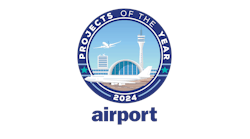According to the English playwright and novelist Theodore Hook, "The best way to predict the future is to invent it." This is especially true in the aviation industry as the future comes at lightning speed for aviation infrastructure design and construction. Because of such rapidly changing advancements, designers must be able to invent the future with innovative, flexible and adaptable design approaches.
Consistently challenging the status quo, learning from the best of the best in other industries, and taking a long view ensures successful airport projects that serve our clients – and their clients - now, and well into the future. Tapping into the expertise and talents of a diverse group of team members, and thorough engagement with the end users, facilitates innovation and exceeds client expectations. The process includes more than the specific design elements and construction; most importantly, it understands the client’s business goals, and that getting a good return on investment is essential.
Adaptability and Flexibility
Over the last few decades, adaptability and flexibility have played an increasingly important role in the planning, design, and construction of commercial airports. New technologies are a response to passenger expectations as well as both airlines’ and airports’ desire for increased efficiencies; they offer innovative solutions to the passenger, baggage, and cargo journey and will ultimately deliver significant long-term value to all airport business partners.
An illustrative example of design flexibility is the recent development of an airport Consolidated Rent-A-Car (ConRAC) facility. Halfway through construction, the client grew concerned about the trend towards traveler’s increased preference for rideshare services and the rapid changes in intermodal transportation connecting airports to rail service. They questioned whether the facility was going to be obsolete before it was completed.
The solution is to design the structure to function in a more flexible way. With creative planning, a facility doesn’t have to always be what it once was. A new ConRAC, with the right structural components in place, the ability to accept ductwork and electrical systems, the right ceiling heights and vertical circulation, can eventually morph into a hotel, an apartment building, an office/administration building, or some combination thereof. This exciting long-term strategy requires more time and effort upfront, but it is taking the development of aviation infrastructure solutions to an entire new level.
Innovation and Challenging the Status Quo
What do you think of when you hear the term modular construction? In the past, designers and builders thought of elements that have standard sizes, can be easily connected and replaced if one goes missing – rather like playing with LEGO bricks or Bristle Blocks. Today, our industry needs to consider how a structure can be adapted for future utility and how a building’s kit of parts, such as walls, floors and ceilings can be partially or totally deconstructed for alternative functionality.
The time to challenge the status quo is now. Consider passenger boarding bridges (PBBs). Why are we still boarding passengers onto aircraft in the same fashion as we have for the past 50 years? It’s time to reconsider the entire process and how built solutions will address the needs of passengers with disabilities and the shared desire for improving efficiency, safety, and security.
Customers, and their needs, have evolved. Adapting to these changes as we develop infrastructure solutions can result in a more efficient and comfortable boarding process. It’s not just a matter of adding more seats in the gate areas. We must consider what type of seats, how many, and do they provide the right solution? Understanding how people arrive at the front-door of an airport and how they ideally maneuver through the terminals will influence how we design gate / hold rooms, including PBBs for maximum results.
Speed of Technology
Today’s air travel population spends increasingly more money on technology hardware and applications. Listening to and helping our airport and airline clients understand how technology can enhance the passenger experience is critical. The cost of staying ahead of, or in some cases catching up to, tomorrow’s technological advances always relates to the bottom line.
Passenger satisfaction can be increased by incentivizing travelers or compensating them, in real time, if there are disrupted operations. This protocol has shown a significantly positive reaction from passengers on social media and is equally as beneficial for occasional travelers as it is for frequent fliers. As architects and engineers, we think about technology as more than supplying enough WiFi bandwidth – though this is critical. Designers consider how best to incorporate rapidly advancing technology, such as AI and virtual reality to provide individualized information to passengers on their journey from curbside to gate, and back.
It's about People
Designers cannot overlook the human aspect of aviation architecture as the future unfolds. Our end users are not just the Passenger Name Reference on their boarding pass; they are young adults going off to college, grandparents flying in for an annual visit, friends on a thrilling adventure, businesspeople pursuing opportunities, and much more. It is a wonderful responsibility to create a human stage on these cities within cities where people act out so many scenes of their lives.
The same can be said for employees of all airport business partners, who are more than the bar code on their badges and account for a notable portion of the financial transactions associated with operating an airport. If, by design, we can reduce the time required to turn around aircraft, because we implemented a better document scanning, boarding or a smarter queuing process, then we’ve contributed the success of numerous aviation business. Improving efficiencies, and creating safer, more secure environments, contributes to workplace and passenger satisfaction.
By taking a considered, long-view approach to designing for the future, we demonstrate flexibility, innovation, and collaboration. A clear business understanding becomes tangible through managing and maintaining project costs to allow clients can see a good return on their significant investments. Utilizing creative methods, mind-blowing technology, and continually looking into the future allows us to elevate the design and functionality of nearly every aspect of the airport experience for everyone.
Yvonne Bilshausen serves as vice president, national aviation architecture principal, and west division aviation leader for HNTB. She specializes in strategic planning, project leadership, and client management on aviation infrastructure programs for numerous airlines and airports. Based in Los Angeles, Bilshausen leads the development and implementation of the firm’s aviation strategy in the West; develops bespoke client service plans, leads project pursuits, provides representation within the aviation industry, and continues to successfully serve aviation clients throughout the country.






